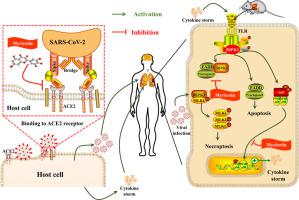Phytomedicine ( IF 7.9 ) Pub Date : 2023-05-05 , DOI: 10.1016/j.phymed.2023.154858 Hudan Pan 1 , Jinlian He 2 , Zifeng Yang 3 , Xiaojun Yao 2 , Han Zhang 4 , Runfeng Li 5 , Yao Xiao 6 , Caiping Zhao 2 , Haiming Jiang 5 , Yuntao Liu 6 , Zhanguo Li 7 , Bin Guo 8 , Chuanhai Zhang 2 , Run-Ze Li 9 , Liang Liu 10

|
Background
Myricetin (3,5,7-trihydroxy-2-(3,4,5-tri hydroxyphenyl)-4-benzopyrone) is a common flavonol extracted from many natural plants and Chinese herb medicines and has been demonstrated to have multiple pharmacological activities, such as anti-microbial, anti-thrombotic, neuroprotective, and anti-inflammatory effects. Previously, myricetin was reported to target Mpro and 3CL-Pro-enzymatic activity to SARS-CoV-2. However, the protective value of myricetin on SARS-Cov-2 infection through viral-entry facilitators has not yet been comprehensively understood.
Purpose
The aim of the current study was to evaluate the pharmacological efficacy and the mechanisms of action of myricetin against SARS-CoV-2 infection both in vitro and in vivo.
Methods
The inhibitory effects of myricetin on SARS-CoV-2 infection and replication were assessed on Vero E6 cells. Molecular docking analysis and bilayer interferometry (BLI) assays, immunocytochemistry (ICC), and pseudoviruses assays were performed to evaluate the roles of myricetin in the intermolecular interaction between the receptor binding domain (RBD) of the SARS-CoV-2 spike (S) protein and angiotensin-converting enzyme 2 (ACE2). The anti-inflammatory potency and mechanisms of myricetin were examined in THP1 macrophages in vitro, as well as in carrageenan-induced paw edema, delayed-type hypersensitivity (DTH) induced auricle edema, and LPS-induced acute lung injury (ALI) animal models.
Results
The results showed that myricetin was able to inhibit binding between the RBD of the SARS-CoV-2 S protein and ACE2 through molecular docking analysis and BLI assay, demonstrating its potential as a viral-entry facilitator blocker. Myricetin could also significantly inhibit SASR-CoV-2 infection and replication in Vero E6 cells (EC50 55.18 μM), which was further validated with pseudoviruses containing the RBD (wild-type, N501Y, N439K, Y453F) and an S1 glycoprotein mutant (S-D614G). Moreover, myricetin exhibited a marked suppressive action on the receptor-interacting serine/threonine protein kinase 1 (RIPK1)-driven inflammation and NF-kappa B signaling in THP1 macrophages. In animal model studies, myricetin notably ameliorated carrageenan-induced paw edema in rats, DTH induced auricle edema in mice, and LPS-induced ALI in mice.
Conclusion
Our findings showed that myricetin inhibited HCoV-229E and SARS-CoV-2 replication in vitro, blocked SARS-CoV-2 virus entry facilitators and relieved inflammation through the RIPK1/NF-κB pathway, suggesting that this flavonol has the potential to be developed as a therapeutic agent against COVID-19.
中文翻译:

杨梅素通过阻断病毒进入促进剂和抑制大鼠和小鼠的炎症而具有抗 SARS-CoV-2 感染的效力
背景
Myricetin (3,5,7-trihydroxy-2-(3,4,5-tri hydroxyphenyl)-4-benzopyrone) 是一种从许多天然植物和中草药中提取的常见黄酮醇,已被证明具有多种药理活性,例如抗微生物、抗血栓形成、神经保护和抗炎作用。此前,据报道杨梅素将 Mpro 和 3CL-Pro 酶活性靶向 SARS-CoV-2。然而,杨梅素通过病毒进入促进剂对 SARS-Cov-2 感染的保护价值尚未得到全面了解。
目的
本研究的目的是评估杨梅素在体外和体内对 SARS-CoV-2 感染的药理功效和作用机制。
方法
在 Vero E6 细胞上评估了杨梅素对 SARS-CoV-2 感染和复制的抑制作用。进行了分子对接分析和双层干涉测量法 (BLI) 测定、免疫细胞化学 (ICC) 和假病毒测定,以评估杨梅素在 SARS-CoV-2 刺突 (S) 受体结合域 (RBD) 分子间相互作用中的作用蛋白和血管紧张素转换酶 2 (ACE2)。在体外THP1巨噬细胞以及角叉菜胶诱导的爪水肿、迟发型超敏反应 (DTH) 诱导的耳廓水肿和 LPS 诱导的急性肺损伤 (ALI) 动物模型中检测了杨梅素的抗炎效力和机制.
结果
结果表明,通过分子对接分析和 BLI 测定,杨梅素能够抑制 SARS-CoV-2 S 蛋白的 RBD 与 ACE2 之间的结合,证明其作为病毒进入促进剂阻断剂的潜力。杨梅素还可以显着抑制 SASR-CoV-2 在 Vero E6 细胞中的感染和复制 (EC 5055.18 μM),使用含有 RBD(野生型、N501Y、N439K、Y453F)和 S1 糖蛋白突变体 (S-D614G) 的假病毒进一步验证。此外,杨梅素对 THP1 巨噬细胞中受体相互作用的丝氨酸/苏氨酸蛋白激酶 1 (RIPK1) 驱动的炎症和 NF-kappa B 信号传导具有显着的抑制作用。在动物模型研究中,杨梅素显着改善大鼠角叉菜胶诱导的爪水肿、DTH 诱导的小鼠耳廓水肿和 LPS 诱导的小鼠 ALI。
结论
我们的研究结果表明,杨梅素在体外抑制 HCoV-229E 和 SARS -CoV-2 复制,阻断 SARS-CoV-2 病毒进入促进剂,并通过 RIPK1/NF-κB 通路减轻炎症,表明这种黄酮醇具有开发潜力作为 COVID-19 的治疗剂。



























 京公网安备 11010802027423号
京公网安备 11010802027423号